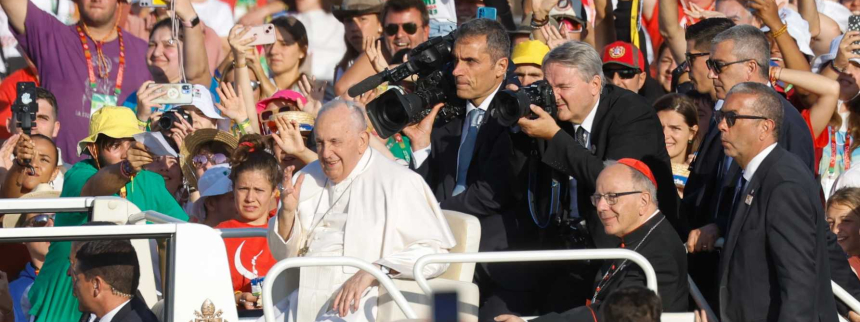
In photo above, Pope Francis, accompanied by Cardinal Manuel Clemente of Lisbon, Portugal, arrives at Tejo Park in Lisbon for the closing World Youth Day Mass Aug. 6, 2023. (CNS photo/Lola Gomez)
World Youth Day events usually occur during the months of July and August. There have been exceptions to this historical pattern, but the world gathering of Catholic youth is usually a summer event. So it was this year, 2023. After fears and precautions of the past years due to the global pandemic, Catholic youth from around the world gathered with their bishops and the Holy Father, Pope Francis, in Lisbon, the capitol of Portugal.
Summer weather is not always kind to the youthful multitude. Most times the weather is hot and humid. Sydney, Australia in 2008 was cool and in the evenings cold — August being a winter month down under. Lisbon has welcomed the world with pleasant coastal weather. Most days hover in the mid-70s degrees, Fahrenheit. One day spiked into the 80s. The weather forecast indicated a severe high temperature warning for today: 87 degrees.
This bonanza of a welcoming climate includes the people of Lisbon.The gracious inhabitants of this historical Portuguese city have embraced the extraordinary global convening of young men and women. Thousands of Portuguese have volunteered to assist the pilgrims. Their bright yellow shirts are everywhere. In my different assignments during World Youth Day, the volunteers have cheerfully accompanied me and ably guided me to a variety of destinations.
The first destination, undertaken in the company of other bishops, was the renowned and beloved Marian shrine to the Blessed Virgin Mary, Nossa Senhora de Fatima (Our Lady of Fatima). On the Monday before the beginning of the World Youth Day activities, my brother bishops, accompanying staff, and me were taken by bus on an 90 minutes ride into the hills of the central region in Portugal where a grand plaza welcomes pilgrims from around the world. On the day of our visit, the plaza was already teeming with youthful fervor. A late morning sun reflected off the white stones of the wide plaza stretched between two Basilica Churches. The older Basilica of Our Lady of the Holy Rosary of Fatima was begun in 1928.
On the other end of the Plaza is a newer Basilica dedicated in 2007 to the honor of the Most Holy Trinity. In the middle of the plaza nestled closer to the older Basilica is the Chapel of the Apparitions. A modern canopy shelters the original humble shrine built to one side of the oak tree where the Blessed Virgin Mary appeared to the three young shepherds, Jacinta, Francisco, and Lucia. The canopy is held up by walls of clear glass, providing an unobstructed view of the sacred site where the story of Fatima began. The tree is no longer there. In its place stands a beautiful image of Our Lady of Fatima. In front of the ancient shrine and image is a small stone altar and pews made of stone.
The bishops and I joined local bishop, the Most Rev. José Ornelas Carvalho for the 11 a.m. celebration of the sacrifice of the Mass at the outdoor sanctuary built in front of the older Basilica of Our Lady of the Holy Rosary. There were easily more than 1,000 p lgrims gathered for the Mass. For the recessional following the Mass, the priests and bishops processed into the chapel of the apparition where we were privileged to stand near the image of our Blessed Mother and her ancient first abode in Fatima. Together we sang the Salve Regina.
Among the words of the ancient, haunting hymn are, “Ad te clamamus exsules filii Hevae” (to you we cry, poor banished children of Eve). These words or similar, in every language echoing the perennial plea, come to the woman dressed in dazzling white whose head seems to nod near to those who looked upon her with the singular hope, “Et Iesum, benedictum fructum ventris tui, nobis post hoc exsilium ostende.” (After this our exile, show unto to us the blessed fruit of thy womb, Jesus.

